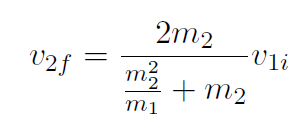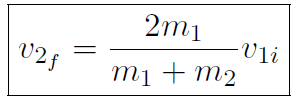


 الفيزياء الكلاسيكية
الفيزياء الكلاسيكية
 الكهربائية والمغناطيسية
الكهربائية والمغناطيسية
 علم البصريات
علم البصريات
 الفيزياء الحديثة
الفيزياء الحديثة
 النظرية النسبية
النظرية النسبية
 الفيزياء النووية
الفيزياء النووية
 فيزياء الحالة الصلبة
فيزياء الحالة الصلبة
 الليزر
الليزر
 علم الفلك
علم الفلك
 المجموعة الشمسية
المجموعة الشمسية
 الطاقة البديلة
الطاقة البديلة
 الفيزياء والعلوم الأخرى
الفيزياء والعلوم الأخرى
 مواضيع عامة في الفيزياء
مواضيع عامة في الفيزياء|
Read More
Date: 13-9-2020
Date: 14-3-2021
Date: 22-11-2020
|
Elastic Collisions in 1-dimension
Recall our work energy theorem for a single particle,

or

or

If WNC ≠ 0 then energy will not be conserved. For a two-body collision process, then an inelastic collision is one in which energy is not conserved (i.e. WNC ≠ 0), but an elastic collision is one in which energy is conserved (WNC = 0). Now if you think of a collision of two billiard balls on a horizontal pool table then Uf = mgyf and Ui = mgyi, but yf = yi and thus Uf = Ui or ΔU = 0. Thus the above work-energy theorem would be

Thus for collisions where Ui = Uf , we often say more simply that an elastic collision is when the kinetic energy alone is conserved and an inelastic collision is when it is not conserved. In this section we first will deal only with elastic collisions in 1-dimension.
Example A billiard ball of mass m1 and initial speed v1i hits a stationary ball of mass m2. All the motion occurs in a straight line. Calculate the final speeds of both balls in terms of m1, m2, v1i, assuming the collison is elastic (Is this a good assumption?).
Solution All the motion is in 1-dimension and so conservation of momentum (with v2i = 0) is just

and conservation of kinetic energy is

Here we have two equations with the two unknowns v1f and v2f . Thus the rest of the problem is simply doing some algebra. Let's solve for v1f in the first equation and then substitute into the second equation to get v2f. Thus

or

Substituting this into the conservation of kinetic energy equation gives

which simplifies to

giving

which is finally

Substituting this back into the conservation of momentum equation gives

which gives

or

There are some interesting special situations to consider.
1) Equal masses (m1 = m2). This implies that v1f = 0 and v2f = v1i. That is the projectile billiard ball stops and transfers all of its speed to the target ball. (This is also true if the target is moving.)
2) Massive target (m2 >> m1). In this case we get v1f  -v1i and
-v1i and  which means the projectile bounces off at the same speed and the target remains stationary.
which means the projectile bounces off at the same speed and the target remains stationary.
3) Massive projectile (m1 >> m2). Now we get v2f  -v2i and v1f
-v2i and v1f  -v1i meaning that the projectile keeps charging ahead at about the same speed and the target moves off at double the speed of the projectile.
-v1i meaning that the projectile keeps charging ahead at about the same speed and the target moves off at double the speed of the projectile.



|
|
|
|
"عادة ليلية" قد تكون المفتاح للوقاية من الخرف
|
|
|
|
|
|
|
ممتص الصدمات: طريقة عمله وأهميته وأبرز علامات تلفه
|
|
|
|
|
|
|
المجمع العلمي للقرآن الكريم يقيم جلسة حوارية لطلبة جامعة الكوفة
|
|
|